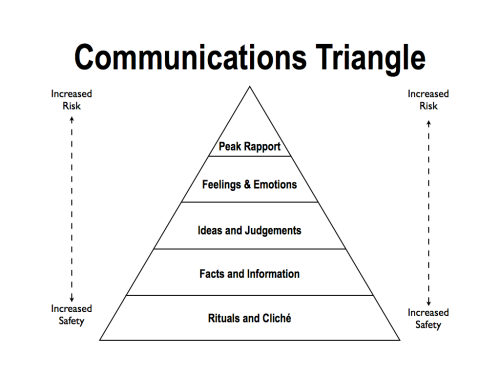A little-known communications model provides useful guidance for authentic sharing online.
Friend lists were ignored by Facebook – and went largely unheard of amongst users – in the drive to encourage public sharing. The developers of Google+ however, realised that whilst some people are comfortable with public sharing (ala Twitter), others demand privacy, only sharing with social circles based on context or familiarity.
Context-based friend lists (such as work and interests) are easy to implement – music, photography, workplaces etc. It can be harder to grasp how familiarity works online, and this is where the Communications Triangle1 is useful: The Communications Triangle describes levels of interaction, from the ‘rituals & clichés’ of meeting-and-greeting, to the profound familiarity of ‘peak rapport’. Even good friends begin conversations by exchanging pleasantries, but they can access higher levels quickly due to mutually developed trust and understanding.
The Communications Triangle describes levels of interaction, from the ‘rituals & clichés’ of meeting-and-greeting, to the profound familiarity of ‘peak rapport’. Even good friends begin conversations by exchanging pleasantries, but they can access higher levels quickly due to mutually developed trust and understanding.
People don’t tend to share ‘ideas and judgements’ or ‘feelings and emotions’ with those they don’t know (or trust). That’s why conversations with casual acquaintances frequently centre on facts and information.
Friend lists can be aligned to the Comms Triangle, with acquaintances seeing content shared across lower levels, and ‘friends’ or ‘family’ seeing more of an individual’s ideas, solutions and judgements, feelings and emotions.
Trust of course is a factor, and so is perceived risk. Good friendships are worth a risk though, so new acquaintances can be fast-tracked to higher levels, whilst other people can step up as we get to know them better.
The Communications Triangle can guide the development of friend lists and circles online, supporting authentic interactions based on familiarity and trust. Perhaps it’s a model that can help you?
—
1A common adaptation of the source found here:
Barnes, P., & University of Strathclyde. (1997). ‘Theory into practice’: The complete practical theory of outdoor education and personal development. Glasgow: Faculty of Education, University of Strathclyde.
Barnes’ original is not available online but is discussed in this book:
Beard, C., & Wilson, J. P. (2006). Experiential learning: A best practice handbook for educators and trainers. London: Kogan Page.
Finally, a similar adaptation (with an additional ‘Gossip and Grapevine’ level) is here:
Williams, M. R. (2005). Leadership for leaders. London: Thorogood Pub.



